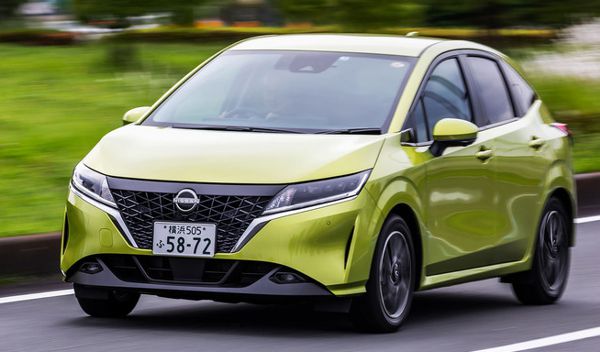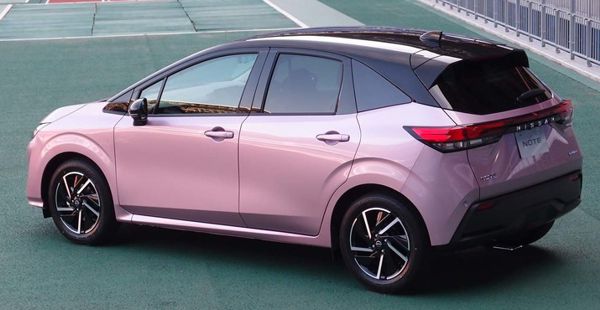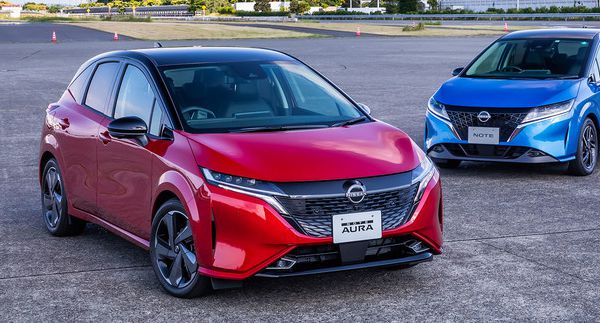Published
on 4
Oct 2021
|
All rights reserved.
|
|
|

|
|
Nissan
Note goes upmarket with e-Power series hybrid system.
|
|
Went on sale in Japan in
late 2020, the third generation Note remains a tall-body B-segment
hatchback, but its intent of going upmarket is obvious. Prices start
from 2 million yen, versus 1.57 million yen of the cheapest Honda Fit
or 1.4 million yen of Toyota Yaris, its biggest rivals, and this can
rise to 2.7 million yen for top model Aura before options. How can
Nissan persuade buyers that it is worth the premium? The answer is
e-Power, Nissan’s series hybrid power system.
e-Power is not new to Nissan. It is also found on Kicks small crossover
and Serena MPV. Nissan introduced e-Power to the last generation Note
in 2016 with quite a success, turned out to take 70 percent of all
sales. With e-Power, Nissan could earn higher profit margin from the
Note, while the much cheaper petrol-powered model struggled to earn a
profit due to stiffer competition. Therefore, the firm decided to
abandon petrol models completely and offer solely e-Power this time
around.
e-Power is the market’s only series hybrid system. Its engine works
only as a generator to turn a generation motor, which supply
electricity to power the propulsion motor. This means, the engine has
no mechanical connection to wheels. In essence it is an electric car,
just differs in needing an engine to work constantly. You might ask,
why not let the engine drives the wheels directly and save the
conversion losses? In a series hybrid, the engine tries to work as much
as possible at its sweet zone, i.e. 2000-3500 rpm, which is the rev
range it delivers the highest efficiency. As there is no mechanical
connection to the wheels, the engine does not need to rev up and down
according to throttle. The gap between power supply and demand can be
bridged by the battery. When more power is demanded, the battery
supplements. When the car slows down, surplus power from the engine can
be used to recharge the battery. In other words, the battery is a
buffer, stabilizing the engine rev. Only when sustaining high power is
required (such as driving on highway), the engine will rev close to its
redline, then its energy efficiency might drop below a conventional
powertrain. In practice, especially in urban driving, series hybrid is
proved to be efficient. The new Note returns a fuel consumption of
38.2km per liter according to JC08 standard, a lot higher than the 25.2
km/l figure of the last generation car fitted with 1.2-liter petrol
engine and CVT. It is also a bit more efficient than the last
generation e-Power model, which returned 37.2 km/l.

|
|
Drives
like an EV, but petrol engine is not refined enough.
|
|
The e-Power system of the new Note evolves from the last one. It still
consists of a 1.2-liter 3-cylinder engine and two electric motors, all
are mounted transversely under the bonnet and drive the front axle like
a conventional FF car. Meanwile, a lithium battery is placed under the
front seat so that it does not rob any luggage space. The petrol engine
has its output lifted slightly from 79 to 82 horsepower. More
importantly, the propulsion motor is improved from 109 to 116
horsepower, and its torque from 187 to 206 lbft, giving the car
stronger performance. Like an electric car, it delivers all that 206
lbft of torque right from start, so initial acceleration feels strong.
From 45 mph, the hot hatch feel fades out rapidly. Expect 0-60 mph
takes about 8.5 seconds. For sure it feels very brisk in urban driving,
but not so good on highway.
The lithium battery is very small at 1.54kWh, so its zero-emission
range is a joke, about 3 miles, but then it is not a plug-in hybrid.
When the motor works at maximum power, a fully charged battery may last
for 3 minutes, then it becomes as slow as a 82hp engine hauling a
1220kg car can be. However, since its top speed is capped at 93 mph
(150 km/h), this situation is difficult to happen.
The control strategy has been refined from the last generation. While
the old car had a rather abrupt acceleration and deceleration
characteristic, the new car gets much smoother. To that end,
regenerative braking force is reduced. “One pedal driving” is still
possible in Eco mode, but the effect is reduced, so you need to touch
the brake in case stronger deceleration is required. Moreover,
regenerative braking no longer brakes to complete stop, so drivers
accustomed to driving EVs might find it less convenient.
In the old car, the petrol engine intervenes with apparent noise and
vibration. This is made less intrusive in the new car, thanks to better
installation as well as more effective noise insulation, although under
hard acceleration it still exhibits too much noise. Besides, Nissan
programmed the hybrid powertrain such that it avoids starting the
engine on quieter, smoother roads as far as possible. Conversely, when
the car is riding on rough roads (as detected by wheel sensors), it
takes the opportunity to recharge the battery, because the cabin is
noisy anyway.

|
|
Cabin
gets smaller but more premium feeling.
|
|
The new car is built on the CMP-B platform of Renault-Nissan alliance.
Chassis rigidity is up by 30 percent. Strangely, Nissan made it smaller
than before, cutting its length and wheelbase by 55mm and 20mm,
respectively, although width and height are unchanged. This means,
while the rear seat is still tolerable by a six-footer, it no longer
feels superior. Admittedly, as the third generation won’t sell in
Europe and North America anymore – Singapore is its only export market
– Nissan thinks a smaller size won’t hurt sales. On the contrary, it
cuts 10kg and shortens turning radius.
Inside, the dashboard looks more upmarket than before, thanks to a
stepped dashboard design and flat panel display. The latter looks a bit
like Mercedes at the first glance, but there is an abrupt step between
the 7-inch instrument and 9-inch center touchscreen, and the LCD
instrument is actually a combination of analogue and digital, let alone
its dark and unattractive graphics. All plastics are hard, but the
touch surfaces of the floating transmission tunnel and door grab
handles are synthetic leather. The “gear selector” looks premium, and
the flat-bottom steering wheel looks sporty.
At the back, a pair of passengers up to 6-foot tall can fit, but there
is no foot space beneath the driver seat due to the location of
battery. Strangely, despite no drive shaft to the rear axle (including
4WD model), there is still a prominent transmission tunnel at the rear
floor, robbing it the opportunity for fitting the third passenger. At
the back, the boot has a volume of 340 liters, not bad, and there is a
tool space under the false floor. On the downside, the split rear seats
don’t fold flat, making it less versatile than Honda Fit.
Design-wise, the new Note is quite handsome. Its “Timeless Japanese
Futurism” design theme follows the Aria electric crossover. Crisper
lines, a cleaner front end – thanks, no cumbersome "V-motion" grille
here – and protruding taillights constitute a modern look.

|
|
Aura
wants to be a premium supermini, a target too high.
|
|
On the road, the stronger performance and higher powertrain refinement
are noticeable, the suspension resists roll well, but ride quality is
quite poor. Rear seat passengers feel especially harsh over bigger
bumps and ridges. It feels less stiff on the driver seat, but still not
a comfortable ride. The steering is light and numb in Nissan’s fashion.
Keen drivers will be better served by Toyota Yaris.
4WD and Aura
The Note is offered with 4WD option, where another motor is added to
the rear axle, offering 68hp and 74lbft at a weight penalty of 120kg.
However, unlike a 2-motor EV, it is not tuned for performance, but
designed as a security means when driving on snow.
Another derivative is called Aura instead of Note. Its body is widened
by 40mm, all goes to the extended wheel arches which house the 17-inch
wheels and 20mm wider tires. There are also subtle tweaks to the front
grille, front and rear bumpers etc. Inside, you will find classier
trims including fabrics on dash and door cards, some wood grain panels
and a 12.3-inch, more colorful LCD instrument that can be used to
display sat-nav map. The cabin features more sound insulation and
laminated front windows. The propulsion motor is uprated to 136hp and
221lbft for stronger performance, though the harsh suspension is
unaltered. The Aura is sold as a premium small car, with prices far
exceeding any B-segment rivals, higher even than a Toyota Prius!
Everybody wants to sell cars at premium prices, of course. In the end,
the market will decide whether it is worth the extra. In the first half
of this year, Nissan sold 47,000 copies of Note, an increase of just 12
percent from the old car recorded at the same period last year.
Meanwhile, Toyota Yaris topped the sales chart at 119,000 units, and
that’s before you consider another 118,000 sales in Europe.
|
Verdict:    |
|